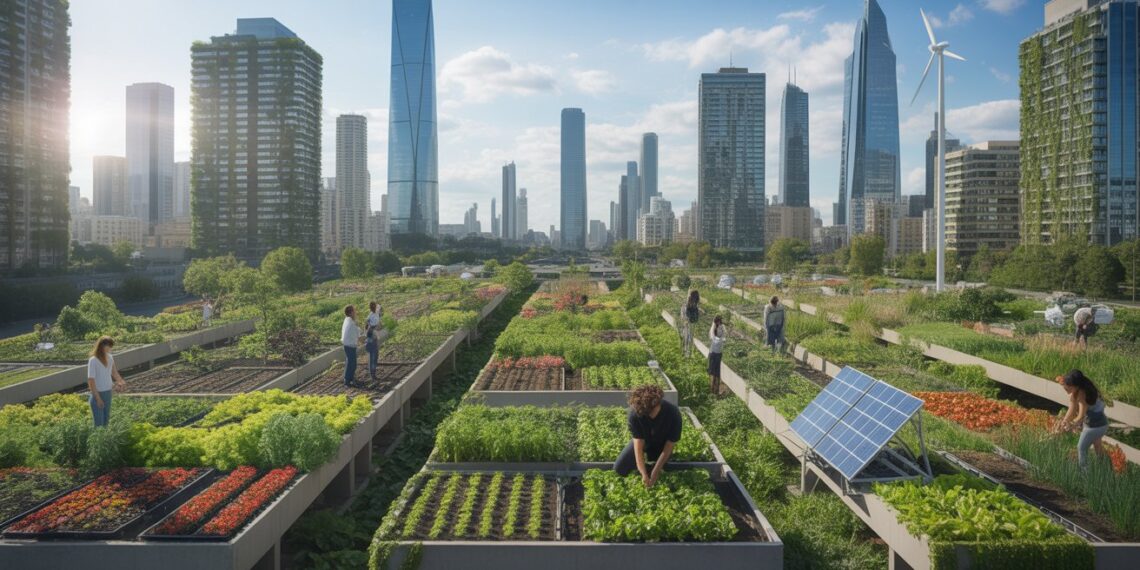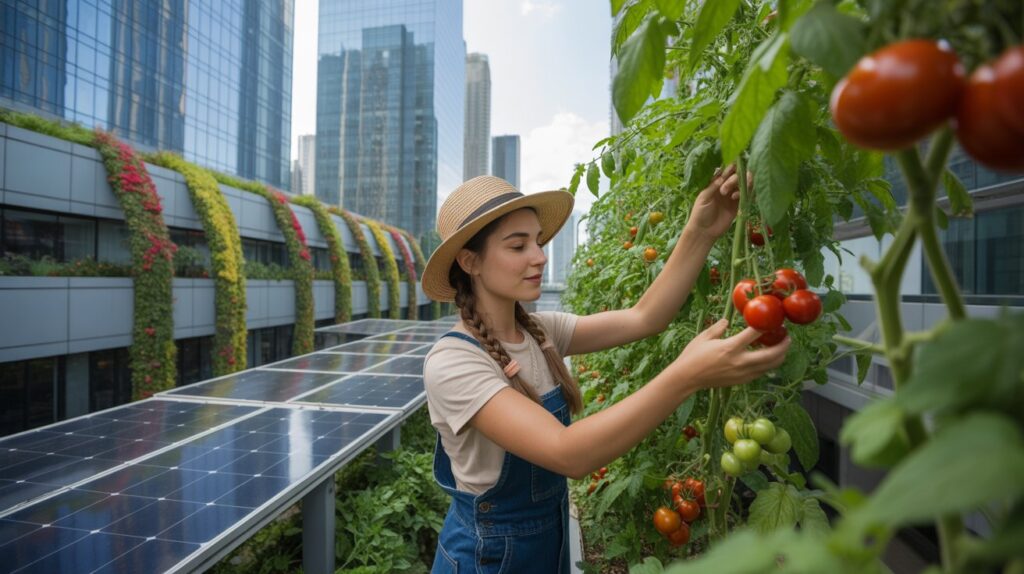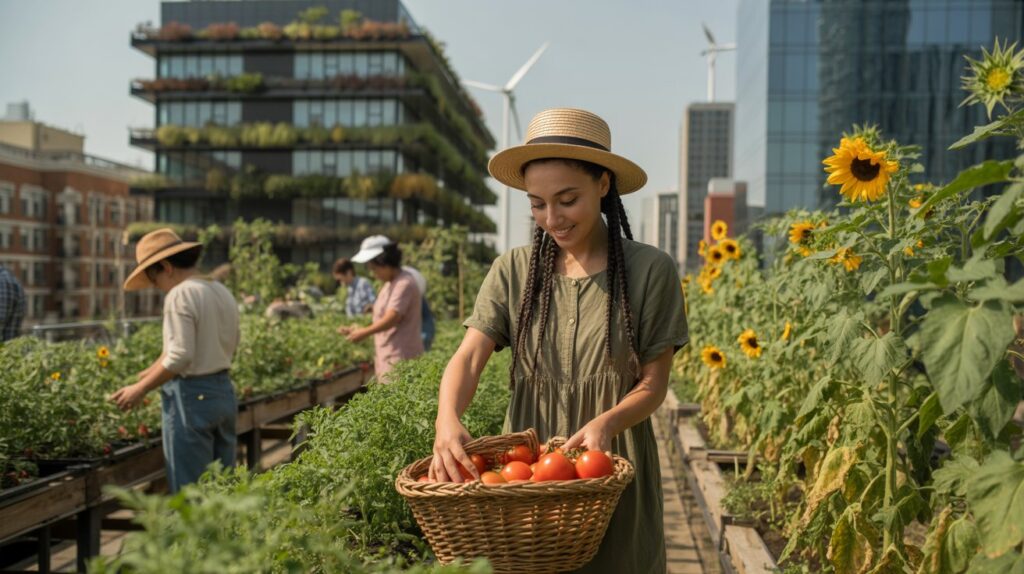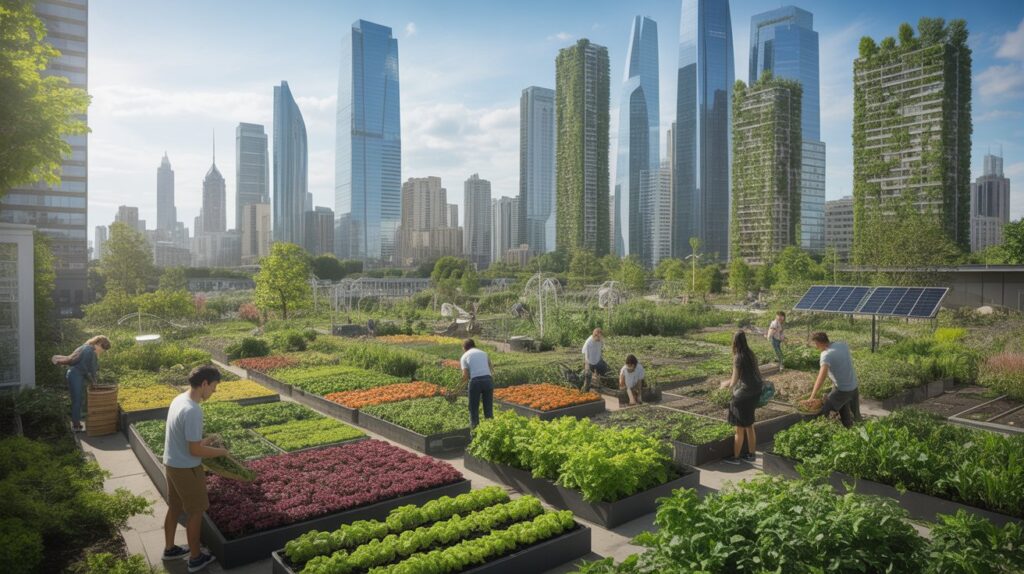Urbanization is accelerating at an unprecedented rate, with more than two-thirds of the world’s population expected to live in cities by 2050. This trend has intensified the demand for food, energy, and natural resources, while also putting immense pressure on the environment. Against this backdrop, urban farming has emerged as a promising solution. More than just growing vegetables on rooftops or balconies, urban farming represents a holistic approach that addresses environmental, economic, and social challenges simultaneously. In this article, we explore how urban farming contributes to sustainability, examine its multidimensional benefits, address challenges, and discuss future prospects.
What Is Urban Farming?
Urban farming, also known as urban agriculture, refers to the cultivation, processing, and distribution of food in or around urban areas. It encompasses a wide range of practices, such as:
- Rooftop gardens
- Vertical farming systems
- Community gardens
- Hydroponics and aquaponics
- Container and modular farms
Unlike traditional agriculture, urban farming is closely integrated with city infrastructure and designed to meet the specific needs of dense populations.
Environmental Contributions of Urban Farming
1. Reducing Carbon Emissions
One of the most significant ways urban farming contributes to sustainability is by reducing carbon footprints. Locally grown food eliminates or shortens supply chains, thereby reducing “food miles” — the distance food travels from farm to consumer. This translates into lower fuel consumption and fewer greenhouse gas (GHG) emissions.
2. Mitigating Urban Heat Island Effect
Green rooftops and urban gardens contribute to cooling city environments. Plants provide shade and release moisture through evapotranspiration, reducing the “urban heat island” effect. This improves urban microclimates, decreases reliance on air conditioning, and lowers energy consumption.
3. Enhancing Biodiversity
Urban farming creates micro-habitats for pollinators such as bees, butterflies, and birds. By integrating diverse crops and companion planting, it supports greater biodiversity within cities and reconnects urban dwellers with nature.
4. Promoting Waste Recycling
Cities generate vast amounts of organic waste. Urban farming provides a system for recycling this waste through composting, vermiculture, or anaerobic digestion. Nutrient-rich compost can then be used to improve soil quality or sustain hydroponic systems.
5. Water Efficiency
Advanced systems such as hydroponics and aquaponics use up to 90% less water than conventional farming. Rainwater harvesting and greywater reuse further improve water efficiency in urban farms.
Economic Benefits of Urban Farming
1. Reducing Food Costs
By producing food locally, urban farms reduce dependency on expensive supply chains. This helps lower food prices for consumers, particularly in food-insecure urban areas.
2. Job Creation and Local Economies
Urban farming stimulates local economies by creating jobs in farming, distribution, agritech, and education. From small-scale community gardeners to high-tech vertical farms, opportunities exist across multiple skill levels.
3. Encouraging Entrepreneurship
Urban agriculture fosters innovation. Entrepreneurs are launching businesses around hydroponic farms, modular systems, and urban farm-to-table models. Startups focused on indoor farming technologies and AI-driven crop management are thriving.
4. Reducing Import Dependency
Many urban centers rely heavily on imported produce, making them vulnerable to global supply disruptions. Urban farming builds resilience by reducing reliance on external food sources.
Social Contributions of Urban Farming
1. Improving Food Security
Urban farming directly addresses food insecurity by providing fresh, locally grown produce in food deserts — areas with limited access to affordable, nutritious food.
2. Enhancing Nutrition and Public Health
Fresh produce from urban farms is often more nutrient-rich, as it doesn’t spend weeks in transport or storage. This contributes to healthier diets, reducing risks of chronic diseases linked to poor nutrition.
3. Building Community and Social Cohesion
Community gardens bring neighbors together, creating social bonds and fostering collective responsibility. Urban farms often serve as educational spaces, teaching children and adults about nutrition, sustainability, and ecology.
4. Cultural and Educational Value
Urban agriculture reconnects people with food traditions, encourages intergenerational knowledge sharing, and serves as a practical platform for environmental education.
Challenges and Trade-offs in Urban Farming
Despite its many benefits, urban farming faces challenges that must be addressed for it to scale sustainably.
1. Limited Land Availability
Urban spaces are expensive and scarce. Allocating land for agriculture requires innovative solutions such as rooftop farming, vertical farming, and integration into green infrastructure.
2. Soil and Environmental Contamination
Soils in cities may be contaminated with heavy metals, industrial pollutants, or other toxins. This necessitates soil testing, raised beds, or soil-free systems like hydroponics.
3. High Energy Demand in Controlled Environments
Indoor farms with artificial lighting and climate control can consume significant energy. Unless powered by renewable energy, this reduces their environmental benefits.
4. Policy and Regulatory Barriers
Urban zoning laws, building codes, and lack of supportive policies can hinder the establishment of urban farms. Governments need to create enabling environments through incentives and regulatory adjustments.
5. Economic Viability
While community gardens are often self-sustaining, commercial urban farms must balance high operating costs against competitive food prices. Scaling profitably remains a challenge.
Innovations and Best Practices
1. Vertical Farming
Stacking crops in controlled environments maximizes productivity per square meter. This system often integrates hydroponics, LED lighting, and AI monitoring.
2. Hydroponics and Aquaponics
Soilless farming methods allow cultivation in compact urban spaces. Aquaponics, which combines fish farming with plant production, creates closed-loop ecosystems.
3. Rooftop Farming
Converting underused rooftop spaces into gardens improves insulation, reduces stormwater runoff, and supplies fresh produce locally.
4. Smart Farming Technologies
IoT sensors, AI algorithms, and automated irrigation systems are improving efficiency and productivity while minimizing waste.
5. Policy and Planning Integration
Cities like Singapore, Paris, and Havana have integrated urban farming into urban planning, offering incentives and embedding agriculture into city design.
Case Studies
1. Singapore’s Vertical Farms
Singapore’s “30 by 30” initiative aims to produce 30% of its food locally by 2030. Vertical farms and hydroponic systems are central to this goal.
2. Havana, Cuba
In response to food shortages, Havana developed organopónicos — urban organic farms that now supply a significant portion of the city’s produce.
3. Detroit, USA
Detroit has transformed vacant lots into thriving community farms, providing food security and revitalizing neighborhoods.
4. Tokyo, Japan
Tokyo integrates rooftop farming and high-tech vertical farms, blending modern technology with limited urban land.
Local and Regional Perspectives
In South Asia and countries like Pakistan, urban farming has immense potential. With high urban population density, rising food prices, and water scarcity, urban farming offers practical solutions:
- Rooftop hydroponics in Karachi and Lahore
- Community gardens in densely populated neighborhoods
- Potential integration with renewable energy projects
These practices can strengthen food security while addressing climate resilience.
Future Outlook
Urban farming is more than a passing trend; it is becoming a cornerstone of sustainable cities. Advances in biotechnology, renewable energy integration, and AI-driven agriculture will further increase productivity and reduce costs. Policymakers are beginning to see urban agriculture as a tool for climate resilience, public health, and economic development.
If supported with the right investments and governance frameworks, urban farming could transform cities into greener, healthier, and more self-reliant ecosystems.
Frequently Asked Questions (FAQs)
1. What are the main environmental benefits of urban farming?
Urban farming reduces carbon emissions, improves air quality, mitigates urban heat islands, and promotes biodiversity.
2. Is urban farming economically viable?
While community-based urban farms are typically sustainable, commercial ventures face challenges due to high costs. Innovations in technology and policy support are improving viability.
3. Can urban farming solve food insecurity?
Urban farming alone cannot eliminate food insecurity but significantly contributes by providing affordable, fresh produce in urban food deserts.
4. How does urban farming address climate change?
By reducing food miles, recycling waste, and promoting green infrastructure, urban farming lowers carbon emissions and strengthens climate resilience.
5. What role do governments play in supporting urban farming?
Governments can provide policy incentives, adjust zoning laws, fund pilot projects, and integrate urban farming into city planning.
Conclusion
Urban farming is not a silver bullet for all sustainability challenges, but it is a powerful, multifaceted solution. It addresses environmental issues by reducing emissions and promoting biodiversity, strengthens local economies through job creation and innovation, and fosters healthier, more resilient communities. While challenges such as limited land, high energy use, and regulatory barriers remain, innovations in technology and supportive policies are paving the way forward.
Ultimately, how urban farming contributes to sustainability depends on how cities, communities, and individuals embrace it as part of a broader transformation toward resilient, inclusive, and sustainable urban living.












